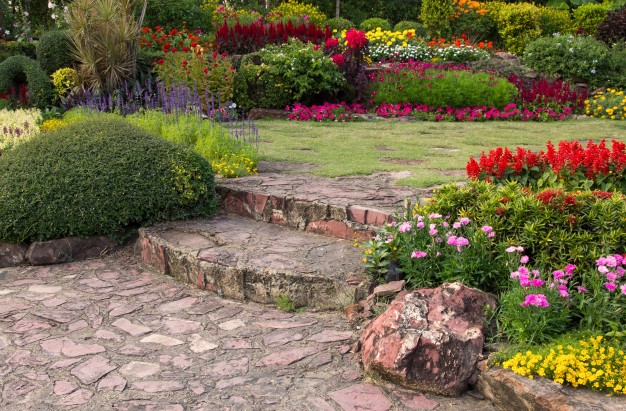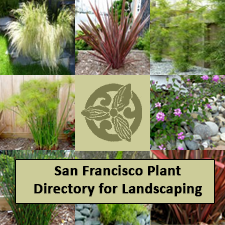
As a San Francisco landscape contractor, we’re often asked which plants are best for our Mediterranean climate, cool winds and foggy skies. There is a huge array of potted plants, flowering shrubs and large trees that do well in our backyards. Today, we’ll cover just a few of them that would flourish here. Whether you’re in North Beach, Visitacion Valley, Parkmerced, Outer Richmond or anywhere in between, there’s a plant for you.
Native San Francisco Plants for Landscaping Projects
A lot of people go for exotic plants, but native plants are excellent candidates for almost any landscaping project. The Douglas Iris (Iris douglasiana), for example, is a beautiful wildflower native to San Francisco. It’s pretty blue and cream flowers are a great choice to spruce up sidewalks or roof gardens.
Rosa californica, the California wildrose, is another example of a beautiful, hardy native. Its color ranges through the shades of pink from almost white to deep red during the spring and summer. If you need a hedge, it’s an excellent candidate; it’s easy to take care of, with low water requirements once established. An added benefit, besides the pleasant fragrance, is the draw for birds and butterflies. It’s best as a backdrop for your garden.
Around Market Street, you can grow the Western Columbine, Aquilegia formosa. A spring perennial, this little red and yellow bell hangs down, dangling bright yellow stamen like wind chimes. If you like hummingbirds (and who doesn’t?), this is a great choice. If you were ever looking for a plant that does well on the damp, northern side of your house, look no further than the Western Columbine.
Another California native is the Dudleya spp, or the Live Forever. A pale blue-green succulent with red tips, the Live Forever does great for sidewalk displays. While they need sun, they can go quite a bit without water.
It’s San Francisco brother, the Dudleya farinose (also called the Live Forever) is a mix between chalky white and bright red foliage, with a little yellow flower that blooms in the spring. This succulent is a good-looking ornament in any garden as a low-lying grounder. Plant farinose next to concrete or a small, trickling water feature and it will take its moisture from that. Bonus: it attracts hummingbirds and does well in landscape scenes with rocks, water features and sand.
Exotic and Non-native Landscaping Plants for San Francisco Gardens
The above isn’t the end-all, be-all of native plants by far; there are numerous beautiful and useful plants that got their start right here in San Francisco. However, there are just as many exotics and non-natives that would do well in your garden.
The Chinese Fringe Flower (Loropetalum Chinense) is just an example, and one we like to use in our garden designs. It has gorgeous, frilly pink or white flowers, and leaves that range from deep green to deep plum, depending on the time of year. It’s a toss-up whether this is a fast-growing shrub or a moderately growing tree, but it’s easy to take care of, whatever it is. Low water, low/no fertilizer – the only off-point is that it grows so fast it may need pruning quicker than you plan!
Another visitor from afar is Mondo Grass (Ophiopogon japonicus), a native of Japan, China and Vietnam. Mondo Grass makes a great small-scale groundcover, with small clumps of dark green leave that look like grass. In the summer you will be surprised by tiny lilac flowers. While many use moss, and we have, ground cover like this—full, thick—gives more dimension to your landscape design.
If you want low maintenance plants, the dwarf Lily of the Nile (Agapanthum Peter Pan) is a beautiful choice. The Nile Lilly is originally from South Africa, fit in with any landscape (including Asian-inspired gardens), and take very little work. Pick your spot, because it does well in little to full sunlight, and takes regular to very little water. For all your hard work, you get a wonderful little plant with bright blue flowers in the summer and fall, and green foliage the rest of the year.
It’s more of an herb than a garden plant, but Borago officinalis adds beauty, whimsy and a hint of practicality for any garden. The flowers bloom in pastel blue, pinkish-purple and white petals with fanciful curly-cue stems holding them up. As well, borage can be used for food, to make a garnish, or simply to become a medicinal drink. It has a lot of uses, but our favorite is as a part of clients’ gardens.
Conclusion
As you can see, there are a lot of choices for plants to add to your landscape project, some native and some not-so-native. No matter where you are in the process of landscape design, we can help provide you with the best choices based on your location and need. Contact Tamate Landscaping to get the right mix of plants for your needs.


